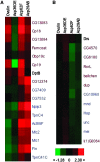Post-mating gene expression profiles of female Drosophila melanogaster in response to time and to four male accessory gland proteins
- PMID: 18562649
- PMCID: PMC2475742
- DOI: 10.1534/genetics.108.086934
Post-mating gene expression profiles of female Drosophila melanogaster in response to time and to four male accessory gland proteins
Abstract
In Drosophila melanogaster, the genetic and molecular bases of post-mating changes in the female's behavior and physiology are poorly understood. However, DNA microarray studies have demonstrated that, shortly after mating, transcript abundance of >1700 genes is altered in the female's reproductive tract as well as in other tissues. Many of these changes are elicited by sperm and seminal fluid proteins (Acps) that males transfer to females. To further dissect the transcript-level changes that occur following mating, we examined gene expression profiles of whole female flies at four time points following copulation. We found that, soon after copulation ends, a large number of small-magnitude transcriptional changes occurred in the mated female. At later time points, larger magnitude changes were seen, although these occurred in a smaller number of genes. We then explored how four individual Acps (ovulin, Acp36DE, Acp29AB, and Acp62F) with unique functions independently affected gene expression in females shortly after mating. Consistent with their early and possibly local action within the female, ovulin and Acp36DE caused relatively few gene expression changes in whole bodies of mated females. In contrast, Acp29AB and Acp62F modulated a large number of transcriptional changes shortly after mating.
Figures

Similar articles
-
Genes regulated by mating, sperm, or seminal proteins in mated female Drosophila melanogaster.Curr Biol. 2004 Aug 24;14(16):1509-14. doi: 10.1016/j.cub.2004.08.028. Curr Biol. 2004. PMID: 15324670
-
The Drosophila melanogaster seminal fluid protein Acp62F is a protease inhibitor that is toxic upon ectopic expression.Genetics. 2002 Jan;160(1):211-24. doi: 10.1093/genetics/160.1.211. Genetics. 2002. PMID: 11805057 Free PMC article.
-
A genome-wide analysis of courting and mating responses in Drosophila melanogaster females.Genome. 2004 Oct;47(5):900-10. doi: 10.1139/g04-050. Genome. 2004. PMID: 15499404
-
The gifts that keep on giving: physiological functions and evolutionary dynamics of male seminal proteins in Drosophila.Heredity (Edinb). 2002 Feb;88(2):85-93. doi: 10.1038/sj.hdy.6800017. Heredity (Edinb). 2002. PMID: 11932766 Review.
-
Tokens of love: functions and regulation of Drosophila male accessory gland products.Insect Biochem Mol Biol. 1997 Mar;27(3):179-92. doi: 10.1016/s0965-1748(96)00084-7. Insect Biochem Mol Biol. 1997. PMID: 9090115 Review.
Cited by
-
The progesterone antagonist mifepristone/RU486 blocks the negative effect on life span caused by mating in female Drosophila.Aging (Albany NY). 2015 Jan;7(1):53-69. doi: 10.18632/aging.100721. Aging (Albany NY). 2015. PMID: 25614682 Free PMC article.
-
Odorant and gustatory receptors in the tsetse fly Glossina morsitans morsitans.PLoS Negl Trop Dis. 2014 Apr 24;8(4):e2663. doi: 10.1371/journal.pntd.0002663. eCollection 2014 Apr. PLoS Negl Trop Dis. 2014. PMID: 24763191 Free PMC article.
-
Transcriptome analysis of Anastrepha fraterculus sp. 1 males, females, and embryos: insights into development, courtship, and reproduction.BMC Genet. 2020 Dec 18;21(Suppl 2):136. doi: 10.1186/s12863-020-00943-2. BMC Genet. 2020. PMID: 33339505 Free PMC article.
-
Sperm success and immunity.Curr Top Dev Biol. 2019;135:287-313. doi: 10.1016/bs.ctdb.2019.04.002. Epub 2019 May 15. Curr Top Dev Biol. 2019. PMID: 31155361 Free PMC article. Review.
-
CRISPR/Cas9 Mediated Disruption of Seminal Fluid Protein Sfp62 Induces Male Sterility in Bombyx mori.Biology (Basel). 2022 Apr 7;11(4):561. doi: 10.3390/biology11040561. Biology (Basel). 2022. PMID: 35453761 Free PMC article.
References
-
- Aigaki, T., I. Fleischmann, P. S. Chen and E. Kubli, 1991. Ectopic expression of sex peptide alters reproductive behavior of female D. melanogaster. Neuron 7 557–563. - PubMed
Publication types
MeSH terms
Substances
Grants and funding
LinkOut - more resources
Full Text Sources
Molecular Biology Databases

